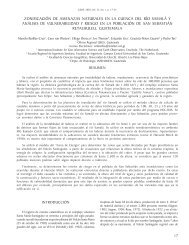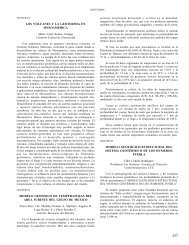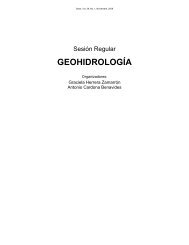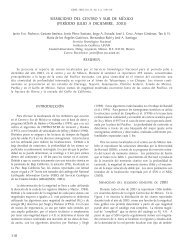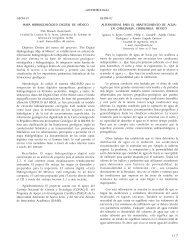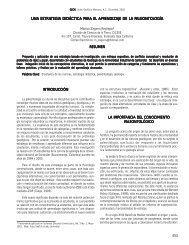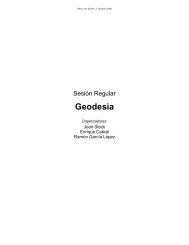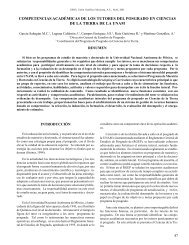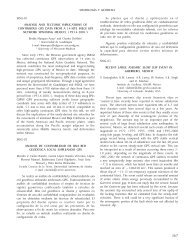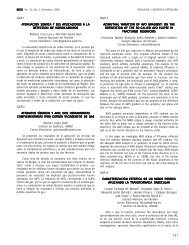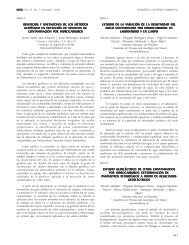SISMOLOGÍA Geos, Vol. 27, No. 1, Octubre, 2007SIS-22CARACTERIZACIÓN DE ENJAMBRESSÍSMICOS EN BAHÍA DE BANDERASNúñez Cornú Francisco, Rutz López Marta,Suárez Plascencia Carlos y Sánchez Aguilar JohnCentro <strong>de</strong> Sismología y Volcanología <strong>de</strong>Occi<strong>de</strong>nte, Universidad <strong>de</strong> Guadalajarapacornu77@gmail.comLa región <strong>de</strong> Bahía <strong>de</strong> Ban<strong>de</strong>ras es una región con gran<strong>de</strong>sesfuerzos tectónicos, <strong>de</strong>bido probablemente a la cercanía <strong>de</strong>lpunto triple. El resultado <strong>de</strong> estos esfuerzos es la alto sismicidadregistrada por la red sismológica. La placa continental presentamuchos rasgos estructurales, resultado <strong>de</strong> estos esfuerzos.Algunos alineamientos <strong>de</strong> sismicidad coinci<strong>de</strong>n con estos rasgosestructurales.Dentro <strong>de</strong> estos alindamientos sísmicos hay enjambressísmicos que presentan características muy similares en su forma<strong>de</strong> onda. Se ha hecho un estudio para caracterizar estas familiasa través <strong>de</strong> correlacionar su forma <strong>de</strong> onda utilizando la técnicadigital <strong>de</strong> correlación cruzada (Maurer y Deichmann, 1995) yrelocalización (Consola y DiGiovambattista, 1987). A partir <strong>de</strong> losdatos disponibles y el análisis <strong>de</strong> correlación cruzada en base auna estación se pudieron <strong>de</strong>finir 17 familias las cuales se asociancon un mecanismo <strong>de</strong> fuente y trayectoria estacionaria.De las 17 familias se eliminaron tres <strong>de</strong>bido a que los datosno tenían la calidad requerida para el análisis <strong>de</strong> correlación yrelocalización.De las 14 familias se caracterizó como evento maestro el <strong>de</strong>mayor magnitud y registrado en el mayor número <strong>de</strong> estaciones.La relocalización epicentral <strong>de</strong> los eventos <strong>de</strong> cada familiaquedaron <strong>de</strong>ntro <strong>de</strong> un radio máximo <strong>de</strong> 1 km.Estas 14 familias están localizadas en la corteza continental,con una profundidad entre 10 y 22 km con excepción <strong>de</strong> lasfamitas M19 y A09 que se encuentran a menos <strong>de</strong> 10 km <strong>de</strong>profundidad.De estas 14 familias que se pudieron relocalizar, solo sepudieron mo<strong>de</strong>lar 11 <strong>de</strong> ellas obteniendo sus planos <strong>de</strong> falla porel método <strong>de</strong> mínimos cuadrados para planos (splane_m). De las11 familias solo para 2 <strong>de</strong> ellas se tenían lecturas suficientes paracalcular su mecanismo focal que en ambos casos es congruentecon el plano <strong>de</strong> falla obtenido. Las 14 familias se pue<strong>de</strong>n asociara lineamientos estructurales lo que sugiere fallas sísmicamenteactivas.SIS-23LA DIMENSIÓN FRACTAL DE LA PLACADE COCOS SUBDUCIDA. UN PARÁMETROPARA CARACTERIZAR SU GEOMETRÍAGuzmán Speziale MarcoCentro <strong>de</strong> Geociencias, UNAMguzmarco@hotmail.comEl ángulo <strong>de</strong> subducción no es el mejor parámetro paracaracterizar a una placa en subducción ya que ésta <strong>de</strong>scribeuna curva. Hemos encontrado que, al menos en el caso <strong>de</strong> laplaca <strong>de</strong> Cocos en subducción, dicha curva se aproxima a unaexponencial, por lo que es posible <strong>de</strong>finir su dimensión fractal.Hemos generado veinte secciones sísmicas perpendicularesa la trinchera mesoamericana que <strong>de</strong>spués proyectamos ensemi-logaritmo. A la sección semi-logarítmica se le ajusta unarecta por mínimos cuadrados . La pendiente <strong>de</strong> esta recta(multiplicada por mil) es la dimensión fractal. La dimensión fractalasí obtenida es directamente proporcional a la inclinación <strong>de</strong> laplaca subducida.La mayor parte <strong>de</strong> la placa subducida presenta una secciónsemi-logarítmica a la que se le pue<strong>de</strong> ajustar una recta.Sin embargo, en la parte central <strong>de</strong> México las seccionespresentan dos segmentos claramente <strong>de</strong>finidos. Estas seccionesse encuentran en el area en la que varios autores han i<strong>de</strong>ntificadouna subducción horizontal bajo el arco volcánico mexicano.Los resultados muestran una variación <strong>de</strong> la dimensión fractalque va <strong>de</strong>s<strong>de</strong> 4.1 bajo Michoacán, a valores cercanos a cero bajoel eje volcánico, para <strong>de</strong>spués pasar a dimensiones que se vanincrementando <strong>de</strong> 3.5 en Chiapas hasta 5.2 en Costa Rica.En términos generales, la dimensión fractal es un valor únicopara la placa subducida <strong>de</strong>finida por la zona <strong>de</strong> Wadati-Benioff,lo que constituye una ventaja sobre el tradicionalmente usadoángulo <strong>de</strong> subducción.SIS-24ASPECTOS DE LA SISMOTECTONICADE NICARAGUA Y SU ALREDEDORFrez Cár<strong>de</strong>nas José y Gamez Balmaceda EnaDivisión <strong>de</strong> Ciencias <strong>de</strong> la Tierra, CICESEjofrez@cicese.mxUtilizamos información electrónica <strong>de</strong> acceso público (líneas<strong>de</strong> costa, catálogos –mundial y regional- <strong>de</strong> hipocentros, asícomo el catálogo CMT/Harvard <strong>de</strong> mecanismos focales) paracaracterizar aspectos <strong>de</strong> la sismotectónica <strong>de</strong> Nicaragua y susalre<strong>de</strong>dores.El estudio se concentró en tres temas. En cuanto a valores <strong>de</strong>lparámetro b <strong>de</strong> la relación <strong>de</strong> Gutenberg-Richter, no encontramosdiferencias significativas en su distribución espacial. Concluimosque el sismo <strong>de</strong>l 13 <strong>de</strong> enero <strong>de</strong> 2001, Mw = 7.7, ha disparado yapor seis años una importante actividad en una región silente en lostres años previos al sismo y aledaña a la zona <strong>de</strong> réplicas, frente ala costa <strong>de</strong> Nicaragua. Esta conexión no ha sido reportada hastaahora y <strong>de</strong>be agregarse a la ocurrida en la ca<strong>de</strong>na volcánica, unmes <strong>de</strong>spués <strong>de</strong>l sismo principal y que ha recibido atención enla literatura.El estudio <strong>de</strong> la distribución <strong>de</strong> los ejes P y T <strong>de</strong> losmecanismos focales <strong>de</strong> la región entrega <strong>de</strong>talles <strong>de</strong>l régimenextensivo <strong>de</strong> la placa en subducción. En particular, comparamoslos valores <strong>de</strong> la inclinación (medida con respecto a la vertical) <strong>de</strong>la placa que resultan <strong>de</strong> a) la proyección vertical y perpendicular ala costa <strong>de</strong> los hipocentros y b) la inclinación <strong>de</strong> los ejes T. Existeacuerdo, <strong>de</strong>ntro <strong>de</strong> los 10º, entre estas dos formas <strong>de</strong> estimación.La inclinación <strong>de</strong> los ejes T muestra una disminución sistemática,con poca variabilidad y gradual, <strong>de</strong>s<strong>de</strong> un valor <strong>de</strong> 36º-45º a unaprofundidad <strong>de</strong> ~70 km hasta valores <strong>de</strong> 20º-13º a la profundidadmáxima <strong>de</strong> 200 km.122
Geos, Vol. 27, No. 1, Octubre, 2007SISMOLOGÍASIS-25 CARTELNEW CONSTRAINTS ON THE SLIP MAGNITUDE OFMAY 22, 1960 CHILE EARTHQUAKE (MW 9.5) BASEDON ESTIMATED TSUNAMI RUN-UP AT EASTER ISLANDFarreras Sanz Salvador y Ortiz Figueroa Mo<strong>de</strong>stoDivisión <strong>de</strong> Oceanología, CICESEsfarrera@cicese.mxThe issue of effective and reliable early tsunami warnings<strong>de</strong>pends on the rapid <strong>de</strong>tection an analysis of seismic and sealevel data. For this purpose, the establishment of a network of realtime sea level sensors with one instrument installed every 100kilometers covering the Pacific ocean coast of Mexico, CentralAmerican and South America is proposed, and a library of forecastwave heights and time arrivals computed by solving the shallowwater long wave equations from synthetic tsunamis generated asa linear summation of groups of Green’s functions from specificsegmented seismic sources is <strong>de</strong>veloped. In a real case, themagnitu<strong>de</strong> of the coseismic dislocation and the location of therupture has to be evaluated from early <strong>de</strong>terminations of theearthquake parameters (i.e. USGS, Harvard) and/or from aninverse analysis of early observations of the tsunami in the vicinityof the generation area, adjusted as time progresses. For thealgorithm test and calibration purposes, the huge transoceanictsunami of may 22 1960, generated by an estimated Mw = 9.5earthquake with an 800 km length rupture area along the southerncoast of Chile, is analyzed. The best fit for rupture area extension,segmentation and fault slip of the dislocation are <strong>de</strong>termined froman inverse analysis of the numerous tsunami observations abroad,and specifically from the impact in Easter Island located just alongthe path of maximum energy propagation, roughly normal to themajor axis of the rupture area. Wave heights in such a placewere estimated from the horizontal transport of the archeologicalmassive structures by the tsunami.SIS-26 CARTELDEFORMACIÓN CAUSADA POR EL SISMO MW=5.4(MAYO 24, 2006) EN EL VALLE DE MEXICALIGlowacka Ewa 1 , Sarychikhina Olga 1 , Munguía Orozco Luis 1 ,Suárez Vidal Francisco 1 , Farfán Sánchez Francisco 1 , Diaz<strong>de</strong> Cossio Batani Gillermo 1 y Guzmán Sandoval Miguel 21 División <strong>de</strong> Ciencias <strong>de</strong> la Tierra, CICESE2 Universidad Autónoma <strong>de</strong> Baja Californiaglowacka@cicese.mxEl sismo con magnitud 5.4 ocurrió en el valle <strong>de</strong> Mexicali eldía 24 <strong>de</strong> mayo (04:20, UTC) <strong>de</strong> 2006 en la cercanía <strong>de</strong>l CampoGeotérmico Cerro Prieto. Este sismo, que es el más fuerte enla zona <strong>de</strong>s<strong>de</strong> el año 1987, causó <strong>de</strong>formaciones superficiales,hundimiento, ruptura superficial y daños materiales significativos.El sismo fue registrado por la red sísmica regional RESNOM,estaciones locales <strong>de</strong> la red <strong>de</strong> acelerómetros, la red <strong>de</strong>instrumentación geotécnica (inclinómetros y grietómetros), y lared <strong>de</strong> piezómetros, todos instalados por el CICESE.En el momento <strong>de</strong> ocurrencia <strong>de</strong>l sismo, en la red geotécnicaestaban funcionando: dos grietómetros, un inclinómetro <strong>de</strong>superficie, dos inclinómetros <strong>de</strong> pozo, un termómetro <strong>de</strong> pozo(todos con registro casi-continuo) y un testigo, a distanciasmenores <strong>de</strong> 6 km <strong>de</strong> la ruptura. Aparte, aprovechando los trabajos<strong>de</strong> nivelación realizados en la zona en la misma temporada,se repitió la medición <strong>de</strong> unos puntos a lo largo <strong>de</strong> un perfil,perpendicular a la ruptura <strong>de</strong>l sismo, obteniendo el valor máximo<strong>de</strong> hundimiento <strong>de</strong> 20cm.Los grietómetros reportaron <strong>de</strong>sniveles <strong>de</strong> hasta 7 cm y losinclinómetros hasta cientos <strong>de</strong> microradianes, y uno <strong>de</strong> ellossaturado.En el presente trabajo presentamos las observaciones <strong>de</strong><strong>de</strong>formación en el espacio y tiempo y comparamos susmagnitu<strong>de</strong>s con resultados <strong>de</strong> imagen <strong>de</strong> InSAR; se discute surelación con la tectónica <strong>de</strong> la zona y la sismicidad reportada. Sepresentan también unas pruebas <strong>de</strong> la mo<strong>de</strong>lación <strong>de</strong> la mecánica<strong>de</strong> ruptura.SIS-27 CARTELINSTALACIÓN DE UNA ESTACIÓN DE BANDAANCHA EN LA ZONA EPICENTRAL DEL SISMO DEXALAPA DE 1920 (M 6.4) Y REGISTROS OBTENIDOSCórdoba Montiel Francisco 1 , Pacheco Alvarado JavierFrancisco 2 , Singh Singh Shri Krishna 2 y Mora González Ignacio 11 Centro <strong>de</strong> Ciencias <strong>de</strong> la Tierra, Universidad Veracruzana2 Instituto <strong>de</strong> Geofísica, UNAMfcordoba@uv.mxEn este trabajo se presenta una <strong>de</strong>scripción <strong>de</strong> las activida<strong>de</strong>srealizadas con el objeto <strong>de</strong> <strong>de</strong>terminar el nivel <strong>de</strong> actividadsísmica actual en la zona epicentral <strong>de</strong>l sismo <strong>de</strong> Xalapa<strong>de</strong> 1920 y conocer las condiciones existentes en torno a laposible reactivación <strong>de</strong> alguna falla preexistente. A pesar <strong>de</strong> queesta es un área <strong>de</strong> actividad mo<strong>de</strong>rada a baja, históricamenteha sido afectada por sismos como el mencionado, que hanimpactado severamente a poblaciones como Cosautlán <strong>de</strong>Carvajal, Ixhuacán <strong>de</strong> los Reyes, Ayahualulco, Teocelo, Xico,Coatepec y Xalapa en el territorio veracruzano y Patlanalá,Chilchotla y Quimixtlán en el estado <strong>de</strong> Puebla.Como primera etapa <strong>de</strong> este estudio se instaló en el centro<strong>de</strong> la población Ixhuacán <strong>de</strong> los Reyes un sismógrafo portátilMEQ-800. Sin embargo, la vibración ambiental y el ruido sísmico<strong>de</strong> fondo no permitieron <strong>de</strong>terminar algún indicio <strong>de</strong> sismicidadlocal. El 7 <strong>de</strong> noviembre <strong>de</strong> 2006, en un segundo sitio ubicado enla periferia <strong>de</strong>l mismo lugar, se instaló una estación temporal <strong>de</strong>banda ancha triaxial CMG 6TD a 28 km <strong>de</strong> la ciudad <strong>de</strong> Xalapa,la cual se mantiene <strong>de</strong>s<strong>de</strong> esa fecha en operación continua yautónoma con una batería y un panel solar en flotación.El análisis <strong>de</strong> los primeros registros permitió <strong>de</strong>terminar elefecto <strong>de</strong> sitio con el fin <strong>de</strong> establecer su calidad. Así mismo, seencontró a partir <strong>de</strong> los sismogramas, que el sitio es a<strong>de</strong>cuadopara el propósito <strong>de</strong> observación <strong>de</strong> sismos locales, <strong>de</strong> particularinterés en este proyecto, sismos regionales e incluso telesismos.Con los registros obtenidos, se está elaborando una base <strong>de</strong>datos que incluye la discriminación <strong>de</strong> eventos en función <strong>de</strong> sudistancia al epicentro.En el caso <strong>de</strong> los sismos locales, se han encontrado eventoscon una diferencia S-P característica <strong>de</strong> aproximadamente 3segundos, por lo que se está consi<strong>de</strong>rando la implementación<strong>de</strong> una red local con sismómetros <strong>de</strong> periodo corto para po<strong>de</strong>rrealizar la localización <strong>de</strong> estos eventos. La intención <strong>de</strong> estetrabajo es también presentar algunos <strong>de</strong> los registros obtenidosy aportar los antece<strong>de</strong>ntes que coadyuven a <strong>de</strong>terminar enproyectos posteriores el marco tectónico <strong>de</strong> la región.123
- Page 1 and 2:
Geos, Vol. 27, No. 1, Octubre, 2007
- Page 3 and 4:
Geos, Vol. 27, No. 1, Octubre, 2007
- Page 5 and 6:
Geos, Vol. 27, No. 1, Octubre, 2007
- Page 7 and 8:
Geos, Vol. 27, No. 1, Octubre, 2007
- Page 9 and 10:
Geos, Vol. 27, No. 1, Octubre, 2007
- Page 11 and 12:
Geos, Vol. 27, No. 1, Octubre, 2007
- Page 13 and 14:
Geos, Vol. 27, No. 1, Octubre, 2007
- Page 15 and 16:
Geos, Vol. 27, No. 1, Octubre, 2007
- Page 17 and 18:
Geos, Vol. 27, No. 1, Octubre, 2007
- Page 19 and 20:
Geos, Vol. 27, No. 1, Octubre, 2007
- Page 21 and 22:
Geos, Vol. 27, No. 1, Octubre, 2007
- Page 23 and 24:
Geos, Vol. 27, No. 1, Octubre, 2007
- Page 25 and 26:
Geos, Vol. 27, No. 1, Octubre, 2007
- Page 27 and 28:
Geos, Vol. 27, No. 1, Octubre, 2007
- Page 29 and 30:
Geos, Vol. 27, No. 1, Octubre, 2007
- Page 31 and 32:
Geos, Vol. 27, No. 1, Octubre, 2007
- Page 33 and 34:
Geos, Vol. 27, No. 1, Octubre, 2007
- Page 35 and 36:
Geos, Vol. 27, No. 1, Octubre, 2007
- Page 37 and 38:
Geos, Vol. 27, No. 1, Octubre, 2007
- Page 39 and 40:
Geos, Vol. 27, No. 1, Octubre, 2007
- Page 41 and 42:
Geos, Vol. 27, No. 1, Octubre, 2007
- Page 43 and 44:
Geos, Vol. 27, No. 1, Octubre, 2007
- Page 45 and 46:
Geos, Vol. 27, No. 1, Octubre, 2007
- Page 47 and 48:
Geos, Vol. 27, No. 1, Octubre, 2007
- Page 49 and 50:
Geos, Vol. 27, No. 1, Octubre, 2007
- Page 51 and 52:
Geos, Vol. 27, No. 1, Octubre, 2007
- Page 53 and 54:
Geos, Vol. 27, No. 1, Octubre, 2007
- Page 55 and 56:
Geos, Vol. 27, No. 1, Octubre, 2007
- Page 57 and 58:
Geos, Vol. 27, No. 1, Octubre, 2007
- Page 59 and 60:
Geos, Vol. 27, No. 1, Octubre, 2007
- Page 61 and 62:
Geos, Vol. 27, No. 1, Octubre, 2007
- Page 63 and 64:
Geos, Vol. 27, No. 1, Octubre, 2007
- Page 65 and 66:
Geos, Vol. 27, No. 1, Octubre, 2007
- Page 67 and 68:
Geos, Vol. 27, No. 1, Octubre, 2007
- Page 69 and 70:
Geos, Vol. 27, No. 1, Octubre, 2007
- Page 71 and 72: Geos, Vol. 27, No. 1, Octubre, 2007
- Page 73 and 74: Geos, Vol. 27, No. 1, Octubre, 2007
- Page 75 and 76: Geos, Vol. 27, No. 1, Octubre, 2007
- Page 77 and 78: Geos, Vol. 27, No. 1, Octubre, 2007
- Page 79 and 80: Geos, Vol. 27, No. 1, Octubre, 2007
- Page 81 and 82: Geos, Vol. 27, No. 1, Octubre, 2007
- Page 83 and 84: Geos, Vol. 27, No. 1, Octubre, 2007
- Page 85 and 86: Geos, Vol. 27, No. 1, Octubre, 2007
- Page 87 and 88: Geos, Vol. 27, No. 1, Octubre, 2007
- Page 89 and 90: Geos, Vol. 27, No. 1, Octubre, 2007
- Page 91 and 92: Geos, Vol. 27, No. 1, Octubre, 2007
- Page 93 and 94: Geos, Vol. 27, No. 1, Octubre, 2007
- Page 95 and 96: Geos, Vol. 27, No. 1, Octubre, 2007
- Page 97 and 98: Geos, Vol. 27, No. 1, Octubre, 2007
- Page 99 and 100: Geos, Vol. 27, No. 1, Octubre, 2007
- Page 101 and 102: Geos, Vol. 27, No. 1, Octubre, 2007
- Page 103 and 104: Geos, Vol. 27, No. 1, Octubre, 2007
- Page 105 and 106: Geos, Vol. 27, No. 1, Octubre, 2007
- Page 107 and 108: Geos, Vol. 27, No. 1, Octubre, 2007
- Page 109 and 110: Geos, Vol. 27, No. 1, Octubre, 2007
- Page 111 and 112: Geos, Vol. 27, No. 1, Octubre, 2007
- Page 113 and 114: Geos, Vol. 27, No. 1, Octubre, 2007
- Page 115 and 116: Geos, Vol. 27, No. 1, Octubre, 2007
- Page 117 and 118: Geos, Vol. 27, No. 1, Octubre, 2007
- Page 119 and 120: Geos, Vol. 27, No. 1, Octubre, 2007
- Page 121: Geos, Vol. 27, No. 1, Octubre, 2007
- Page 125 and 126: Geos, Vol. 27, No. 1, Octubre, 2007
- Page 127 and 128: Geos, Vol. 27, No. 1, Octubre, 2007
- Page 129 and 130: Geos, Vol. 27, No. 1, Octubre, 2007
- Page 131 and 132: Geos, Vol. 27, No. 1, Octubre, 2007
- Page 133 and 134: Geos, Vol. 27, No. 1, Octubre, 2007
- Page 135 and 136: Geos, Vol. 27, No. 1, Octubre, 2007
- Page 137 and 138: Geos, Vol. 27, No. 1, Octubre, 2007
- Page 139 and 140: Geos, Vol. 27, No. 1, Octubre, 2007
- Page 141 and 142: Geos, Vol. 27, No. 1, Octubre, 2007
- Page 143 and 144: Geos, Vol. 27, No. 1, Octubre, 2007
- Page 145 and 146: Geos, Vol. 27, No. 1, Octubre, 2007
- Page 147 and 148: Geos, Vol. 27, No. 1, Octubre, 2007
- Page 149 and 150: Geos, Vol. 27, No. 1, Octubre, 2007
- Page 151 and 152: Geos, Vol. 27, No. 1, Octubre, 2007
- Page 153 and 154: Geos, Vol. 27, No. 1, Octubre, 2007
- Page 155 and 156: Geos, Vol. 27, No. 1, Octubre, 2007
- Page 157 and 158: Geos, Vol. 27, No. 1, Octubre, 2007
- Page 159 and 160: Geos, Vol. 27, No. 1, Octubre, 2007
- Page 161 and 162: Geos, Vol. 27, No. 1, Octubre, 2007
- Page 163 and 164: Geos, Vol. 27, No. 1, Octubre, 2007
- Page 165 and 166: Geos, Vol. 27, No. 1, Octubre, 2007
- Page 167 and 168: Geos, Vol. 27, No. 1, Octubre, 2007
- Page 169 and 170: Geos, Vol. 27, No. 1, Octubre, 2007
- Page 171 and 172: Geos, Vol. 27, No. 1, Octubre, 2007


![Libro de resúmenes [revisión final, 172 páginas] - UGM](https://img.yumpu.com/51565067/123/500x640/libro-de-resamenes-revisian-final-172-paginas-ugm.jpg)
